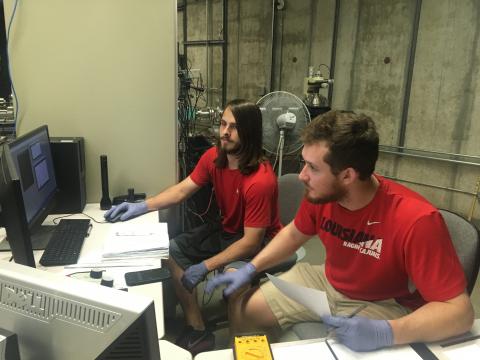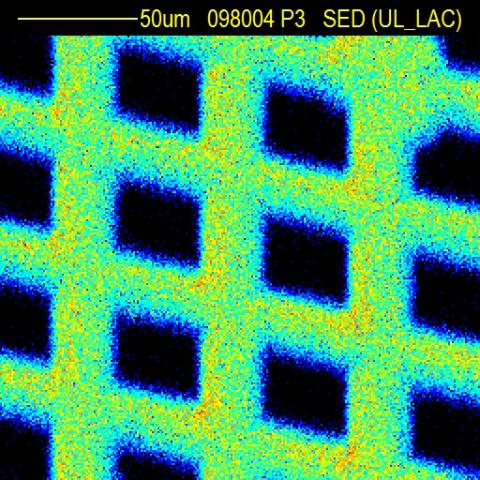Physics Researchers Add Enhancements at LAC
Mon, 06/17/2019 - 9:16amPhysics researchers have added major new enhancements to the microbeam facility at the Louisiana Accelerator Center for users.
Driven by the requirements of the users of the Louisiana Accelerator Center from the Department of Physics, Biology, the New Iberia Research Center and Engineering, a team of researchers from the Department of Physics led by Prof. Dr. Harry J. Whitlow has successfully implemented some significant enhancements to the microbeam facility.

Nick Hendersson (left) and Andre Broussard (right), two physics majors working on tests of the new secondary electron detector system.
The very first secondary electron image of a fine grid obtained from the new system at the LAC. (The skewness correction is turned off.)
Firstly, off-axis scanning transmission ion microscopy (Off-axis STIM) was added by Dr. Naresh Deoli and Armin De Vera in April. This allows us to image thin samples so that details in biological cells and tissue sections can be associated with characteristic X-ray maps showing where heavy elements are concentrated. Next up was an improvement of the microbeam geometry and a new X-ray detector that gave about 20 times improvement in the sensitivity of for measuring heavy elements. The latest improvement was a secondary electron detector (SED) set-up by Nick Hendersson, Andre Broussard and Harry J. Whitlow that not only provides structural information but also simplifies focusing allowing sharper images to be obtained.
The physics challenge is developing the instruments to meet the needs of LAC users. These new developments are being used by Prof. Dr. Paul Klerks and a PhD student Sanjana Banerjee from the Department of Biology as well as Sajan Bhandari a masters student from physics, who together with Prof. DMV Francois Villinger from the NERC and Prof. Dr. Whitlow will study elemental distribution changes in tissues resulting from infection processes. Ashley Mikolajczyk a researcher from the School of Engineering and Dr. Naresh Deoli are using the new capabilities to study how life-elements in alligator eggshells affect breeding. The new capabilities have even found an application in physics where Assist. Prof. Dr. Manavi Jadhav and her research team will use the instrument to characterize meteorites.
